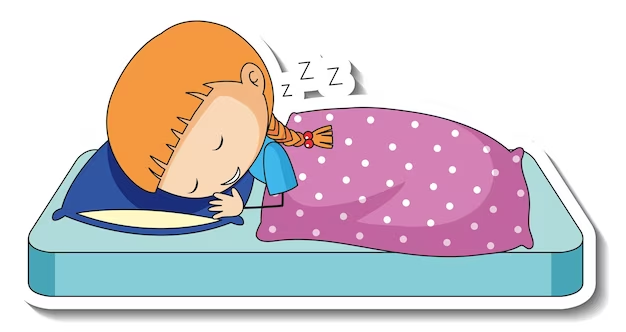Table of Contents
In today’s fast-paced world, sleep often takes a backseat to our daily responsibilities and distractions. However, the importance of quality sleep cannot be overstated. It affects our physical health, mental well-being, and overall quality of life. One way to explore the significance of sleep is through the lens of creative expression, such as clip art. In this article, we’ll delve into the world of clip art and how it relates to sleep, using the specific keyword clip art= sleep.
Understanding the Importance of Sleep

Before we delve into the artistic representation of sleep, let’s first discuss why sleep is crucial for our well-being.
1. Physical Health Benefits
Adequate sleep is essential for maintaining our physical health. It plays a vital role in:
- Cell Repair: While we sleep, our body undergoes processes that repair and regenerate cells, helping to maintain our immune system and overall health.
- Weight Management: Sleep affects hormones that regulate hunger and appetite, making it easier to manage weight.
- Heart Health: Quality sleep can help reduce the risk of cardiovascular diseases, as poor sleep patterns are linked to heart problems.
2. Mental Well-being
Sleep is equally important for our mental health. Insufficient sleep can lead to:
- Cognitive Decline: Memory consolidation occurs during sleep, and a lack of it can impair learning and retention.
- Mood Regulation: Sleep influences our emotional regulation, and inadequate rest can contribute to anxiety and depression.
- Creativity and Problem-Solving: A well-rested mind is more adept at creative thinking and problem-solving, enhancing our productivity.
3. The Connection Between Sleep and Art
Art has always been a reflection of human experience, and sleep is no exception. Throughout history, artists have depicted sleep in various forms, from serene dreamscapes to unsettling nocturnal themes. This leads us to the fascinating world of clip art, particularly the clip art= sleep.
The Role of Clip Art in Visual Communication

Clip art serves as a powerful tool for visual communication. It can simplify complex ideas, evoke emotions, and enhance storytelling. When it comes to the theme of sleep, clip art can effectively convey various aspects, such as relaxation, dreams, and the importance of rest.
1. Conveying Relaxation
Images associated with sleep, such as tranquil landscapes, cozy bedrooms, and peaceful individuals, can evoke a sense of relaxation. These visuals can be utilized in various contexts, from wellness blogs to presentations on the importance of self-care. Using the clip art= sleep, designers can incorporate these calming images into their work, creating a visually soothing experience for the audience.
2. Exploring Dreams
Sleep is often associated with dreams, a subject that has captivated humanity for centuries. Clip art can be used to explore the dream world, showcasing whimsical and imaginative scenes. Illustrations of dream catchers, clouds, and starry nights can evoke a sense of wonder and curiosity, encouraging viewers to reflect on their own dreams and aspirations.
3. Promoting Sleep Awareness
In an era where sleep deprivation is rampant, using clip art to promote sleep awareness is crucial. Illustrative images can help convey the message that quality sleep is essential for overall health. For instance, visual representations of the benefits of sleep, such as improved mood and productivity, can serve as effective reminders for individuals to prioritize rest.
Utilizing Clip Art in Various Contexts
1. In Educational Materials
Educators can leverage clip art to create engaging materials that discuss the importance of sleep. For instance, using clip art= sleep in lesson plans or presentations can help illustrate concepts related to health, biology, and psychology. Visual aids can enhance learning by making complex ideas more accessible and memorable.
2. In Health and Wellness Campaigns
Health and wellness campaigns can benefit from using sleep-themed clip art. Infographics that incorporate visuals can effectively communicate statistics about sleep patterns, tips for better sleep hygiene, and the consequences of sleep deprivation. The clip art= sleep can serve as a central theme, helping to unify the message across various platforms.
3. In Social Media and Marketing
In the world of social media, eye-catching visuals are essential for engagement. Brands promoting sleep products, such as mattresses, sleep aids, or relaxation techniques, can use clip art= sleep to create appealing content. From Instagram posts to Facebook ads, these visuals can resonate with audiences seeking solutions for better sleep.
Finding the Right Clip Art
When searching for clip art, it’s essential to choose images that resonate with your message. Here are some tips for finding the perfect sleep-related clip art:
1. Use Keywords Wisely
When searching for clip art, use specific keywords related to your topic. For example, incorporating phrases like “relaxing sleep,” “dream imagery,” or “sleep hygiene” can yield more relevant results.
2. Explore Various Styles
Clip art comes in different styles, from minimalist designs to more intricate illustrations. Depending on your audience, choose a style that complements your message. For a calming effect, opt for soft colors and gentle lines; for a more energetic vibe, consider bold colors and dynamic shapes.
3. Ensure Quality and Licensing
Always check the quality and licensing of the clip art you choose. There are many free and paid resources available online, but ensure that you have the right to use the images in your projects. High-quality images will enhance the overall aesthetic of your work.
The Future of Clip Art and Sleep Awareness
As society continues to recognize the importance of sleep, the role of clip art in promoting sleep awareness will likely expand. Artists and designers can explore innovative ways to depict sleep and its benefits, using various digital platforms to reach broader audiences.
1. Collaborations with Sleep Experts
Collaborating with sleep experts can enhance the credibility of sleep-themed clip art. Designers can work with professionals to create informative visuals that accurately represent sleep science, making the information accessible to the general public.
2. Interactive Visuals
Incorporating interactive elements into clip art can make the message about sleep even more engaging. For example, creating interactive infographics that allow users to click on different aspects of sleep can provide a deeper understanding of the subject.
3. Social Media Movements
Social media has become a powerful platform for raising awareness about various issues, including sleep health. Clip art can play a significant role in these movements, providing shareable content that encourages discussions about sleep and well-being.
Conclusion
The exploration of sleep through the lens of clip art reveals the profound impact of rest on our lives. As we navigate the challenges of modern living, it’s essential to prioritize sleep and recognize its importance for our physical and mental health. The clip art= sleep serves as a reminder that creative expression can help convey important messages and inspire us to cultivate a culture that values rest.
Incorporating clip art into discussions about sleep can elevate the conversation and create visually engaging experiences that resonate with audiences. Whether used in educational materials, health campaigns, or social media, sleep-themed visuals can foster awareness and encourage individuals to prioritize their well-being. As we move forward, let’s continue to celebrate the power of sleep and the creative expressions that highlight its significance.
FAQS
1. What is clip art, and how is it used?
Clip art refers to pre-made images or illustrations used to enhance visual communication in various media, such as presentations, educational materials, and marketing. It simplifies complex ideas and adds visual appeal to written content.
2. Why is sleep important for our health?
Sleep is essential for physical health, mental well-being, cognitive function, and emotional regulation. Quality sleep supports cell repair, weight management, heart health, and enhances memory and creativity.
3. How can clip art be related to sleep?
Clip art can depict themes of relaxation, dreams, and the importance of sleep. It can be used in educational materials, health campaigns, and social media content to promote sleep awareness and well-being.
4. What benefits does sleep provide for mental health?
Adequate sleep improves mood regulation, cognitive function, and emotional stability. It helps reduce the risk of anxiety and depression while enhancing problem-solving and creative thinking skills.
5. How can educators use clip art related to sleep?
Educators can incorporate sleep-themed clip art in lesson plans, presentations, and handouts to engage students in discussions about health, biology, and psychology, making the concepts more accessible and memorable.
6. What should I consider when selecting clip art for a sleep-related project?
When choosing clip art, consider the style, quality, licensing, and relevance to your message. Use specific keywords in your search to find images that effectively convey the theme of sleep.
7. Can clip art promote sleep awareness?
Yes, clip art can effectively promote sleep awareness by illustrating the benefits of sleep, tips for better sleep hygiene, and the consequences of sleep deprivation, making the information more relatable and engaging.
8. How can businesses use sleep-related clip art in marketing?
Businesses can use sleep-themed clip art in advertising campaigns for products related to sleep, such as mattresses, sleep aids, and relaxation techniques, to attract and engage potential customers.
9. What are some popular themes in sleep-related art?
Popular themes in sleep-related art include dream imagery, peaceful landscapes, cozy settings, and representations of sleep hygiene, which all convey messages of relaxation and self-care.
10. What is the significance of the keyword “clip art= sleep”?
The keyword “clip art= sleep” serves as a focal point in discussions about the relationship between sleep and visual representation. It highlights how specific clip art can be utilized to convey the importance of sleep in various contexts.






